
Earliest source: "[Observatory women computers], 1891." Harvard University Archives / HUV 1210 (9-3). Harvard Libraries, olvwork289691
A group photo of computers at Harvard together with Mary Anna Palmer Draper, aka Mrs. Henry Draper. She's seated in the middle. After her husband's death, she contributed a significant sum of money to continue her late husbands' dream of scientific astrophotograpy, leading to the Draper Catalog, an ambitious project of the Observatory. Many, though not all, computers were funded for this project.
Harvard dates this as 1891. It seems to be approximately the same time as other photos with similar groups of women, taken in the same room. I think there were two pairs of photos taken on different days.
The photo was taken in the long computing room (see 1876 floor plans) on the south side of the second floor (the top floor, excluding the dome) of the building. The photograph was taken facing east, and the doorway in the photo is the closet shown in the floor plan.
Left to right:
Note that Stevens is Mrs. Fleming's maiden name, and she did have other relatives in Boston, but so far I don't know if any of the other Stevens that worked at the Observatary are related.
[Observatory women computers], 1891
1891
General: The women depicted in this photograph analyized stellar photographs and computed data at the Harvard College Observatory.
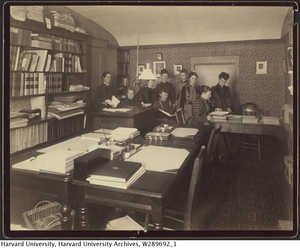
Earliest source: "Observatory girls with Mrs. Draper, 1891
Alternate Title: [Observatory computer room and staff], 1891." Harvard University Archives / HUV 1210 (9-5). Harvard Libraries, olvwork289692
Another photograph taken in the same place and on the same day as the previous, with the same people.

Computers in one of the computing rooms at the Observatory. Harvard's date of 1891 for this photo is probably pretty accurate. It has to be after Dec. 1889, based on the graph on the wall of β Aurigӕ, just behind Antonia Maury (who is credited for discovering that it is a binary star). And as it was published in an April 1892 New England Magazine, thta's the upper limit on the photo.
This is the same location as the photos with Mrs. Draper and some of the computers, the larger computing room on the top floor of the west wing of the Observatory.
From left to right:

Earliest source: "[Observatory computer room and staff], 1891." Harvard University Archives / HUV 1210 (9-4). Harvard Libraries, olvwork289689
Nearly the identical photo as the previous, but with Pickering added standing on the left. Obviously taken the same day.
Note that the women did not work this closely. As can be seen in the above photos with Mrs. Draper, the room is larger and they are crowded together for sake of the photograph. There were between three and five rooms total for the computing work, and by my best guess about 15 women worked there at that time, as well as at least five men. Still cramped, but not this cramped.
The following year, a brick building was constructed to help out with the space issues.

Earliest source: "Observatory [analysis of stellar spectra], 1891." Harvard University Archives / HUV 1210 (9-6). Harvard Libraries, olvwork289693
Date is from Harvard
I think this is Williamina Fleming, seated on the right. The woman on the left may be Mabel C. Stevens, and she's wearing the same dress as one of the women of women computers in the old building with Fleming. Fleming appears to be wearing the same dress also, but without the jacket.
This photo was taken on the same floor as that other photo, but in a the other computer room at the oppisite side of the building.
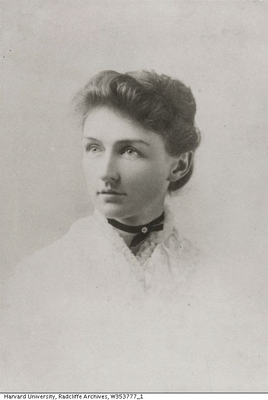
Earliest source: "Portrait of Annie Jump Cannon." Radcliffe College Archives / PC 70-1-2. Harvard Libraries, olvwork353777
The earliest image I've found so far of Annie Jump Cannon. This is what Harvard says: "Inscription: Verso: Miss Annie Jump Cannon of the Harvard observatory, taken while doing graduate work at Radcliffe College", and dates it 1895-1897. This would put her at about 33 years old. She had taken ten years off for lack of available work between Wellesley and Radcliffe. During this she took up photography, published a small book of photographsfootsteps, caught scarlet fever, and lost most of her hearing.wikicannon
I have a small suspicion based on her appearance in other photos that this photo may be much earlier than Harvard's 1896 date, but so far nothing to back it up.
Use/Copyright: Radcliffe College Archives: This image may not be reproduced or transmitted in any form or by any means, electronic or mechanical, without permission in writing from the Radcliffe Archives.
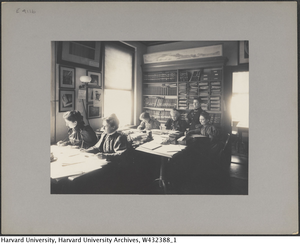
Earliest source: "[Observatory data analysis by women computers] ." Harvard University Archives / UAV 630.271 (E4116). Harvard Libraries, olvwork432388
Women computers working (or posing as if they're working) in a room in the new brick building, built in 1892.
I've dated this photo to March of 1898 based on a calendar visible in the image. The year is not actually legible, but it's a year in which the first was a Tuesday. It also appears (not very clearly) as if the calendar is marked with quarter moon phases, and based on this interpretation, it can only be 1898.
Williamina Fleming is standing. Immediatly in front of her are Eve Leland (back row center) and Ida Woods to the right. The rest are unidentified, although the woman closest to the camera could be A. J. Cannon.
Note: Harvard identifies this as a photo including Henrietta Leavitt. She does not appear in this photo.
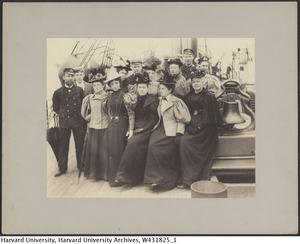
Earliest source: "[Women on-board ship, ca. 1900]." Harvard University Archives / UAV 630.271 (173). Harvard Libraries, olvwork431825
A group of women, most or all computers from the Observatory, on board the C.S. Minia, a cable repair ship. On the early end for possible dates of this picture, Mabel Gill (holding Fleming's hand) was hired in 1892 (assuming she had been hired at this point). At the other end, Fleming passed away in 1911.
The Minia became famous as one of two ships primarily responsible for picking up survivors (and bodies) after the sinking of the Titanic in 1912. Before that, the Minia was a well-known ship under Captain Trott, also well-known for his ability to find and repair broken transatlantic telegram cables, in the deepest seas and the worst weather. He was also known for his hospitality when in port, and this photo could simply have been an opportunity to visit the ship, although he is not one of the gentlemen in this picture.
William Squares DeCarteret took over as captain in 1899 after Trott passed away, and James Adams became his chief officer. In her 1900 journal, Williamina Fleming specifically mentions a letter from "Captain Adams" about the Minia. James Adams did eventually become captain of the Minia but it seems to be at a later date. At any rate, Miss Fleming apparently had some direct connection with an officer on the ship.
Another possible connection would be the Observatory's early interest in telegraphy; they might have had much more direct contact with the ship than your average telegraph customer. Transatlantic cables were used for clock synchronization and precise longitude determinations from the very beginning. In 1873, Joseph Lovering published On the Determination of Transatlantic Longitudes by Means of the Telegraphic Cables.
Also, Captain Trott and at least one crewman were members of the Nova Scotia Institute of Science, which sent their proceedings to the Observatory, so it's possible there were other connections between this ship and the Observatory also.
Left to right:
*I found photos of both captain De Carteret and Adams, and I think it's at least possible that these men are those men, but I may have them reversed as they look like brothers to me.
**I think it looks more like Cannon, and I want it to be her because I actually have no other images (besides very large group shots at conferences) with Fleming and Cannon together. BUT, reasonable estimates of this photo's date would put Cannon in the 35 to 40 range. If this is her she certainly looks MUCH younger than the 1902 photo I have of her.
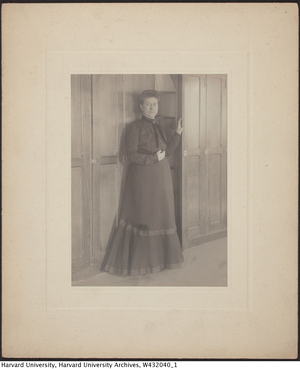
Earliest source: "[Williamina Fleming at Harvard College Observatory plate stacks, ca. 1900]." Harvard University Archives / UAV 630.271 (388). Harvard Libraries, olvwork432040
Williamina Fleming at Harvard College Observatory plate stacks. These are the "new" plate stacks in the brick building addition, built in 1902.
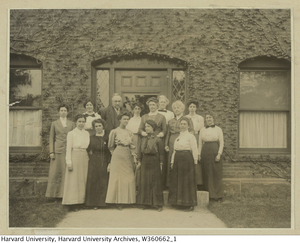
Earliest source: "Observatory Group [photographic group portrait, ca. 1910]." Harvard University Archives / HUPSF Observatory (14). Harvard Libraries, olvwork360662
Harvard calls this photo "Observatory Group", ca. 1910. The Internet often calls it a photo of "Pickering's Harem". I think it's from mid-1911. The lack of Williamina Fleming certainly makes it likely to be after 1911 when she passed away, and Henrietta Leavitt, also absent from the photo, was out of town until late 1911. The photo was taken in the front of the Astrophotographic Library aka, the "Brick Building", aka "Building C."
"Pickering's Harem" may be a modern sexist invention rather than a historic one. I've found no references earlier than 1976 for this phrase. On the other hand, they were much more polite about what the wrote down back then, so it may just as well be a real nickname passed down by oral tradition.
One source that DOES use that nickname, from 1982, also lists a very detailed description of the women in this photo, which I'll just quote here directly:
"At the far left of the photograph is Margaret Harwood (AB Radcliffe 1907, MA University of California 1916), who had just completed her first year as Astronomical Fellow at the Maria Mitchell Observatory. She was later appointed director there, the first woman to be appointed director of an independent observatory. Beside her in the back row is Mollie O'Reilly, a computer from 1906 to 1918. Next to Pickering is Edith Gill, a computer since 1889. Then comes Annie Jump Cannon (BA Wellesley 1884), who at that time was about halfway through classifying stellar spectra for the Henry Draper Catalogue. Behind Miss Cannon is Evelyn Leland, a computer from 1889 to 1925. Next is Florence Cushman, a computer since 1888. Behind Miss Cushman is Marion Whyte, who worked for Miss Cannon as a recorder from 1911 to 1913. At the far right of this row is Grace Brooks, a computer from 1906 to 1920. Ahead of Miss Harwood in the front row is Arville Walker (AB Radcliffe 1906), who served as assistant from 1906 until 1922. From 1922 until 1957 she held the position of secretary to Harlow Shapley, who succeeded Pickering as Director. The next woman may be Johanna Mackie, an assistant from 1903 to 1920. She received a gold medal from the American Association of Variable Star Observers (AAVSO) for discovering the first nova in the constellation of Lyra. In front of Pickering is Alta Carpenter, a computer from 1906 to 1920. Next is Mabel Gill, a computer since 1892. And finally, Ida Woods (BA Wellesley 1893), who joined the corps of women computers just after graduation. In 1920 she received the first AAVSO nova medal; by 1927, she had seven bars on it for her discoveries of novae on photographs of the Milky Way."pickeringsharem
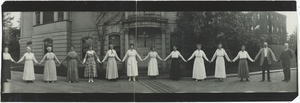
Earliest source: "[Observatory Staff in "paper doll" pose, (in line holding hands) panoramic photograph ca. 1918]." Harvard University Archives / UAV 630.271 (391). Harvard Libraries, olvwork432043
From left to right (primary identifications come from Harvard, who says the names were listed on the back):
I believe the correct names for two of these are "Mary H. Vann" and "Dorothy Block".jaavsoharwood Also, I think this is Mabel, not Edith Gill (or the few other labelled photos I've seen so far similarly mislabel the presumed sisters).
For the longest time I didn't know where pictures like this one were taken. This is an addition to the director's residence added in about 1893 that maybe doubled the size of the residence. The building is not curved, and the brick building to the right is the end of the astrophotographic addition, lying in the same plane. The wide angle just makes it look like a 90 degree bend.
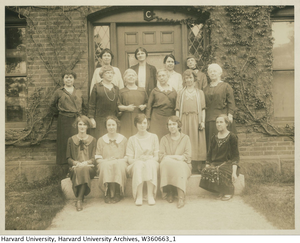
Earliest source: "Observatory Women [photographic group portrait, 1925]." Harvard University Archives / HUPSF Observatory (19). Harvard Libraries, olvwork360663
Harvard says the caption is "As We Were" in the upper left corner, but they must not have scanned that or it is on the back. This is an amazing photo crossing generations of women at Harvard. It's the end of the era of women computers, and the beginning of the era of women scientists.
I found a source identifying the names. Ceclia Payne's expanded autobiography.paynerecollections My guesses were all correct (I skipped five of them).
Back row:
Middle row:
Bottom row:
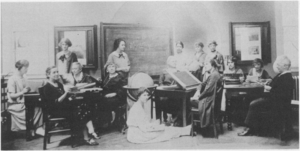
Earliest source: Margaret W. Rossiter. ""Women's Work" in Science, 1880-1910." Isis vol. 71 no. 3. University of Chicago Press, September 1980.womensworksci
Unknown location. (Actually I now believe this may be the west wing of the original building, in the transit room, but after the transit instruments were removed). Source says this photo was taken 19 May, 1925.pickeringsharem
I've only just now noticed that these women are all wearing the exact same outfits as in the other 1925 photo above "As We Were", and so both photos were probably taken on the same day. They appear to be the same set of women, and based on that I've put in the five names I hadn't figured out.
My guesses on identity, left to right:
H. Wilson, A. Maury, A. Hoovens, I. Woods, A. J. Cannon, M. Howe, M. Harwood (on floor), E. Leland, A. Walker, L. Hodgdon, C. Payne (seated), E. F. Gill (standing), M. Walton Mayall, M. Gill, F. Cushman
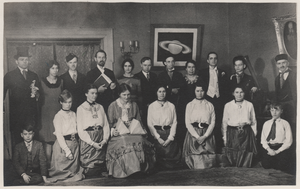
The Cast and Crew of the Observatory Pinafore
A set of six photos of the Observatory Pinfore has recently turned up. They've been scanned by their owner, Charles Reynes, who's the great grandson of Edward Skinner King (who was almost certainly at the performance - he's in the group photo for the AAS conference where the play was staged). They are by far the best quality images I've found anywhere of the performance, and three of them haven't been found anywhere else.
I'm having a particular problem with two identifications from these photographs: G. W. Wheelwright as Winslow Upton and W. R. Ransom as Pickering. I'm hoping to identify the characters from the context of the photos, but at this point I'm not sure that will work. From the opposite end, I've attempted to find photographs of both Wheelwright and Ransom in other contexts. Neither seems to look at all like the character in the photos with the more recessed chin.
Identifications:
Bart J. Bok, unknown women, unknown man, [Wheelwright or Ransom], unknown woman, Harlow Shapley, [Ransom or Wheelwright], Arville Walker, Peter M. Millman, Arthur R. Sayer, Leon Campbell
unknown boy, Mildred Shapley, Adelaide Ames, Cecilia Payne (Gaposchkin), Henrietta Swope, Sylvia Mussels (Lindsay), Helen Sawyer (Hogg), unknown boy
Use/Copyright: Copyright held by Charles Reynes, used here with permission
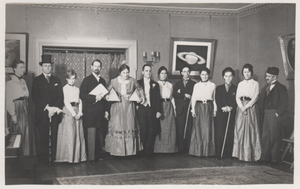
The cast of the Observatory Pinafore
Identifications:
Adelaide Ames (as Rhoda G. Saunders), Bart J. Bok (as Leonard Waldo), Mildred Shapley (as computer), Unknown, Cecilia Payne (as Josephina McCormack), Peter M. Millman (as William Augustus Rogers), Henrietta Swope (as computer), Unknown, Helen Sawyer (as computer), Arthur R. Sayer (as F. E. Seagrave), Sylvia Mussels (as computer), Leon Campbell (as Arthur Searle).
Use/Copyright: Copyright held by Charles Reynes, used here with permission
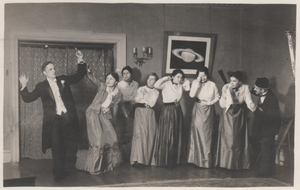
A scene in Observatory Pinafore, where Josephina stops Professor Rogers from killing himself in despair over the defection of his helpful assistant, and circle reader, and whatever else.
This image is the most widely available image of the performance.
Identifications:
Peter Millman, Cecilia Payne-Gaposchkin, Henrietta Swope, Mildred Shapley (daughter of Harlow and Martha Shapeley), Helen Sawyer-Hogg, Sylvia Mussells-Lindsay, Adelaide Ames, Leon Campbell.
These identifications come from the copy of this picture in the Emilo Segre Visual Archive. I've based some of my own identifcations on this list. This is my only source for Mildred Shapley and Sylvia Mussels, all the other faces I've found in other photos (to varying degrees of a satisfactory match, but at least enough of a match to improve my confidence that they're correct).
Use/Copyright: Copyright held by Charles Reynes, used here with permission

A scene from the Observatory Pinafore where Josephina is being pulled away from Professor Rogers by Seagrave and the men of Providence.
I believe this is the point in the play where Josephina is led to the "dungeon".
Identifications:
Unknown, Bart J. Bok, Unknown, Arthur Sayer, Cecilia Payne, Henrietta Swope, Mildred Shapley, Helen Sawyer, Sylvia Mussels, Adelaide Ames.
Use/Copyright: Copyright held by Charles Reynes, used here with permission
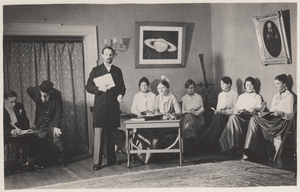
A scene from Observatory Pinfore, with Astronomers and Computers hard at work. Based on the people (and the books), this may be somewhere in the first scene of the play. If so, this could be the Winslow Upton character standing, as the right set of people are on stage for Upton's reciting of "I know the value of a kindly chorus..."
The portrait of Galileo hanging on the right still hangs in the Observatory today; it is the copy by Carlton gifted in 1890.
Identifications
Use/Copyright: Copyright held by Charles Reynes, used here with permission
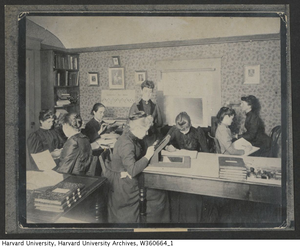
A group of women computers [photographic group portrait, ca. 1900]
ca. 1900

Alternate Title: [Fleming, Williamina P., [photographic portrait, ca. 1900]." Harvard University Archives / HUP Fleming, Williamina (1). Harvard Libraries, olvwork289681
[Williamina P. Fleming, photographic portrait, ca. 1890]
Alternate Title: [Fleming, Williamina P., [photographic portrait, ca. 1900]
ca. 1890
Historical: Williamina Fleming worked at the Harvard College Observatory. She analyized stellar photographs and computed data.
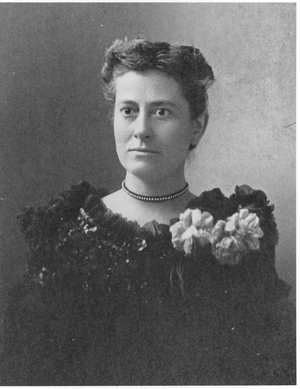
 Fine's Home
Fine's Home